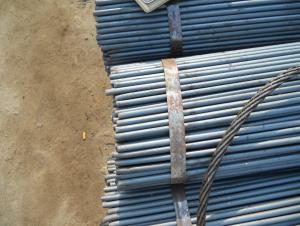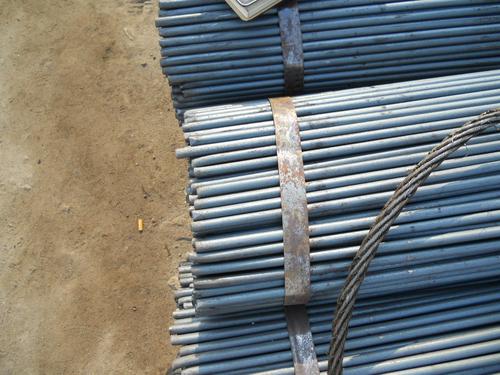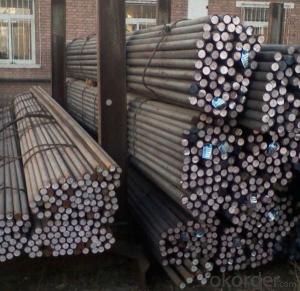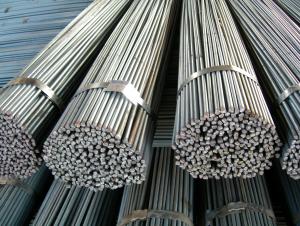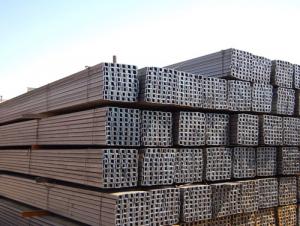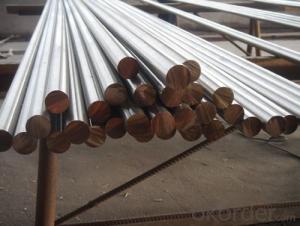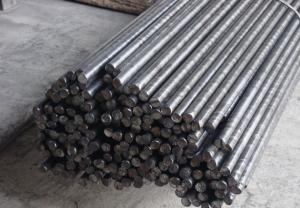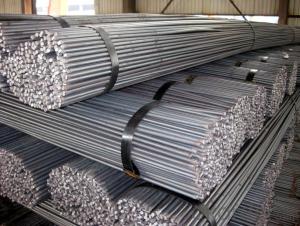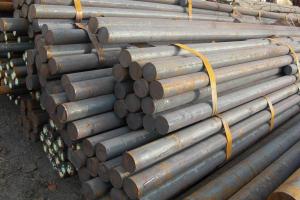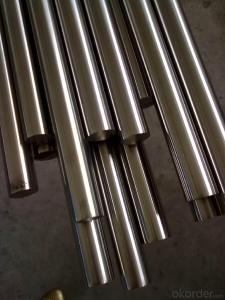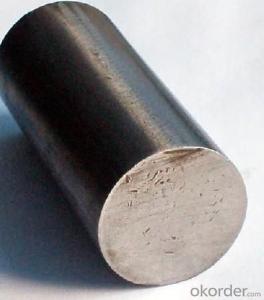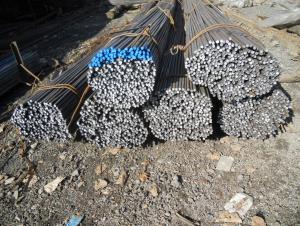Hot Rolled Steel Round Bars of Q195, Q235 for Making Nails
- Loading Port:
- Tianjin
- Payment Terms:
- TT or LC
- Min Order Qty:
- 25 m.t.
- Supply Capability:
- 200000 m.t./month
OKorder Service Pledge
OKorder Financial Service
You Might Also Like
Product Description:
OKorder is offering Hot Rolled Steel Round Bars of Q195, Q235 for Making Nails at great prices with worldwide shipping. Our supplier is a world-class manufacturer of steel, with our products utilized the world over. OKorder annually supplies products to European, North American and Asian markets. We provide quotations within 24 hours of receiving an inquiry and guarantee competitive prices.
Product Applications:
Hot Rolled Steel Round Bars of Q195, Q235 for Making Nails are ideal for structural applications and are widely used in the construction of buildings and bridges, and the manufacturing, petrochemical, and transportation industries.
1. Steel round bar products is used in construction and a large number of architectural and engineering structures. And it can be used in production of handrail, windows, machinery, telecom and curtain wall.
2. It can be used in the fields like metal mines, cement plants, water coal slurry, power stations and chemical industry.
3. Besides, we can supply some especial material steel round bar that can be used for main shaft of steamer, hummer shank, with big section and supper force.
4. Recommended watchcase factory, screw factory and other cold stamping products industry use.
Product Advantages:
OKorder's Hot Rolled Steel Round Bars of Q195, Q235 for Making Nails are durable, strong, and resist corrosion.
1. The steel in which the main interstitial alloying constituent is carbon in the range of 0.12–2.0%.
2. As the carbon percentage content rises, steel has the ability to become harder and stronger through heat treating; however it becomes less ductile.
3. Regardless of the heat treatment, higher carbon content reduces weld ability. In carbon steels, the higher carbon content lowers the melting point.
4. Quality should be in conformity with the specification of the manufacturer. Quantity and packing conditions should be in conformity with the term in the contract.
Main Product Features:
· Premium quality
· Prompt delivery & seaworthy packing (30 days after receiving deposit)
· Corrosion resistance
· Can be recycled and reused
· Mill test certification
· Professional Service
· Competitive pricing
Specifications of Hot Rolled Steel Round Bars of Q195, Q235 for Making Nails
1. Grade: Q235, A36, SS400, S235JR
2. Feature: Unbreakable, grinding resistant and high impact value
3. Diameter: 8mm-150mm
4. Performance: Mainly for civil construction
5. Characteristics: Even hardness, no deformation, no breaking, no mal-roundness
6. Technique: Hot rolled
7. Mass: Mass (kg/m) = Diameter (mm) × Diameter (mm) × 0.00617
Packaging & Delivery of Mild Hot Rolled Steel Round Bars for Bults and Nults
Packaging Detail: All goods are packed in bundle with steel strips and shipped by break bulk vessel or container (depend on target market and different ports)
Delivery Detail: 45 days
Trade terms: FOB, CFR, CIF
MOQ: 25 tons per specification; we can negotiate the quantity if the specification is normal or we have stock of one specification.
Weight: The price invoicing on theoretical weight basis or actual weight basis depends on customer’s request.
Shipment: The shipment of bulk break or container is depends on customer’s request and the situation of the port of destination.
Documents given: Full set of original clean on board bill of lading; Original signed commercial invoice; Original packing list; Policy of insurance; Certificate of origin and what the target market needs.
Production Flow of Hot Rolled Steel Round Bars of Q195, Q235 for Making Nails
Material prepare (billet) — heat up — rough rolling — precision rolling — cooling — packing — storage and transportation
FAQ:
Q1: The products are invoicing on theoritical weight or on actual weight?
A1: We can do it in both manners, according to the customers' request.
Q2: What is the normal tolerance of Hot Rolled Steel Round Bars of Q195, Q235 for Making Nails?
A2: Normally 3%-5%, but we can also produce the goods according to the customers' requests.
Q3: How soon can we receive the product after purchase?
A3: Within three days of placing an order, we will begin production. The specific shipping date is dependent upon international and government factors, but is typically 7 to 10 workdays.
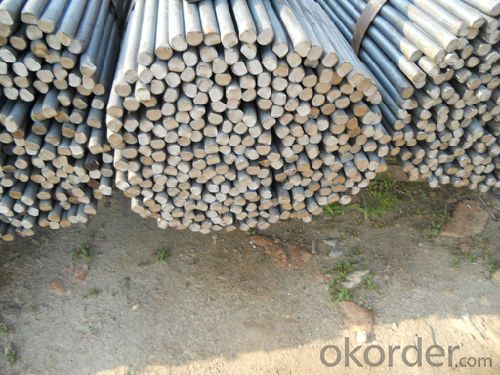

- Q: What is the difference between hot working and cold working of steel round bars?
- Steel round bars can be shaped and manipulated using two different methods: hot working and cold working. Hot working involves shaping steel at high temperatures, typically above the steel's recrystallization temperature. This makes the material more malleable and easier to shape. The processes involved in hot working include forging, rolling, and extrusion. Hot working has several advantages. It allows for the creation of complex shapes and sizes with minimal force or energy. It also improves the mechanical properties of the steel, such as strength and toughness, by refining its grain structure. However, hot working can cause oxidation and scale formation on the steel's surface, which may require additional treatments or cleaning. On the other hand, cold working refers to shaping steel at room temperature or below its recrystallization temperature. Cold working processes include bending, drawing, and cold rolling. Unlike hot working, cold working does not require heating the steel, which reduces energy consumption and production costs. It also results in a smoother surface finish and tighter tolerances compared to hot working. Cold working can increase the hardness and strength of the steel, making it suitable for applications that require higher mechanical properties. However, it can also make the steel more brittle and prone to cracking. In conclusion, the main difference between hot working and cold working steel round bars lies in the temperature at which the shaping process takes place. Hot working is done at high temperatures, making shaping easier and improving mechanical properties. Cold working, on the other hand, is done at room temperature or below, resulting in tighter tolerances and increased hardness. The choice between hot working and cold working depends on the desired properties and characteristics of the final product.
- Q: Can steel round bars be used for making stabilizer bars?
- Yes, steel round bars can be used for making stabilizer bars. Steel round bars are commonly used in various industries, including automotive, for their high strength and durability. Stabilizer bars require materials that can withstand heavy loads and provide stability, making steel round bars an ideal choice for their construction.
- Q: How do steel round bars perform under cyclic loading?
- Steel round bars typically perform well under cyclic loading due to their high strength and ductility. When subjected to repeated or cyclic loading, these bars can withstand significant stress without experiencing deformation or failure. The fatigue behavior of steel round bars is influenced by various factors, such as the material composition, heat treatment, and surface finish. Steel bars with higher tensile strength and hardness tend to exhibit better resistance to fatigue, as they can withstand higher stress levels before failure occurs. Under cyclic loading, steel round bars undergo stress cycles that cause alternating compression and tension forces. These cycles can lead to the initiation and propagation of cracks, ultimately leading to failure. However, steel's inherent ductility allows it to absorb energy and redistribute stress, which helps to mitigate crack propagation and extend the fatigue life of the bar. The fatigue strength of steel round bars is typically determined through fatigue tests, where the bars are subjected to a specified number of stress cycles until failure occurs. The results of these tests provide valuable information on the endurance limit and fatigue life of the steel bar under different loading conditions. To enhance the fatigue performance of steel round bars, various techniques can be employed, such as shot peening, surface coating, and residual stress induction. These techniques can introduce compressive stress on the bar's surface, which helps to inhibit crack initiation and propagation, thereby improving its fatigue resistance. Overall, steel round bars are reliable and durable under cyclic loading, making them suitable for applications that involve repeated or fluctuating stresses, such as structural components, automotive parts, and machinery components. However, it is essential to consider the specific loading conditions, material properties, and design criteria when selecting steel round bars to ensure optimal performance and longevity.
- Q: What are the different shapes available in steel round bars?
- There is a wide range of shapes available for steel round bars, each tailored to meet specific needs and applications. Some commonly used shapes include: 1. Round: This is the most basic and commonly used shape for steel round bars. It has a circular cross-section and finds applications in industries like construction, manufacturing, and engineering. 2. Square: Square steel round bars have a square cross-section, making them ideal for applications that require stability and structural strength. They are often used in constructing frames, supports, and braces. 3. Hexagonal: Hexagonal steel round bars have six flat sides and are utilized in applications that demand better grip and torque resistance, such as machinery and tools. The hexagonal shape ensures a secure connection and prevents slippage. 4. Flat: Flat steel round bars have a rectangular cross-section with two flat sides. They are commonly employed for structural purposes, like building frames, supports, and manufacturing machinery and equipment. 5. Half-round: Half-round steel round bars have a semi-circular cross-section with one flat side. They are frequently used for decorative purposes in architecture, furniture, railings, and handles. 6. Oval: Oval steel round bars have an elongated oval shape, providing a distinctive aesthetic appeal. They are commonly used in decorative applications, like designing furniture, railings, and artistic structures. In summary, the availability of various shapes in steel round bars allows for versatility in different industries. This enables engineers, manufacturers, and designers to select the most suitable shape based on their specific requirements.
- Q: What is the difference between a circle and round steel continuous casting
- Round steel drawn from a continuous casting is called a round billet; the rolled round steel is called a bar.
- Q: How do you measure the diameter tolerance of a steel round bar?
- To measure the diameter tolerance of a steel round bar, you can follow the steps below: 1. Obtain a caliper or micrometer: These measuring tools are commonly used to measure the diameter of objects accurately. 2. Set the measuring tool: If you are using a caliper, adjust the jaws to the appropriate size range. For a micrometer, ensure it is zeroed correctly. 3. Position the round bar: Place the steel round bar on a flat and stable surface, ensuring that it is not rolling or moving. 4. Take the measurement: Use the measuring tool to capture the diameter of the round bar. For accurate results, make sure the tool is perpendicular to the bar and apply gentle pressure to get an accurate reading. 5. Repeat the measurement: To ensure accuracy, take multiple measurements at different points along the length of the round bar. This will account for any variations or deviations in the bar's diameter. 6. Calculate the average diameter: Add up all the measurements and divide by the number of measurements taken. This will give you the average diameter of the round bar. 7. Compare with the tolerance range: Consult the specifications or standards provided for the steel round bar to determine the allowable tolerance range. This range will indicate the acceptable variation in diameter for the bar. 8. Analyze the results: Compare the average diameter obtained from your measurements with the specified tolerance range. If the average diameter falls within the tolerance range, the round bar meets the required specifications. However, if it falls outside the range, the bar may not meet the required tolerance and might need further inspection or adjustment. By following these steps, you can effectively measure the diameter tolerance of a steel round bar and ensure it meets the necessary specifications for your intended application.
- Q: Can steel round bars be used in the manufacturing of home decor?
- Yes, steel round bars can be used in the manufacturing of home decor. They are versatile and can be shaped and welded into various forms, making them suitable for creating furniture, sculptures, and other decorative elements for homes.
- Q: What are the advantages of using nickel-zinc alloy steel round bars?
- There are several advantages of using nickel-zinc alloy steel round bars. Firstly, nickel-zinc alloy steel has a high strength-to-weight ratio, making it an excellent choice for applications where strength and durability are important. This allows for the construction of lighter structures without sacrificing strength or performance. Secondly, nickel-zinc alloy steel round bars have superior corrosion resistance compared to other types of steel. This makes them ideal for use in harsh environments where exposure to moisture, chemicals, or extreme temperatures may occur. The corrosion resistance properties of nickel-zinc alloy steel also contribute to its longevity and ability to withstand the test of time. Additionally, nickel-zinc alloy steel has excellent weldability and machinability, making it easy to work with and manipulate into various shapes and forms. This versatility allows for the creation of complex designs and structures, making it a popular choice in the construction and manufacturing industries. Furthermore, nickel-zinc alloy steel round bars have good thermal and electrical conductivity properties. This makes them suitable for applications that require the efficient transfer of heat or electricity, such as in the production of electrical components or heat exchangers. Lastly, nickel-zinc alloy steel is known for its high resistance to fatigue and wear, making it suitable for applications that involve repetitive or high-stress operations. This ensures that structures or components made from nickel-zinc alloy steel will maintain their performance and integrity over an extended period of time. In summary, the advantages of using nickel-zinc alloy steel round bars include high strength-to-weight ratio, superior corrosion resistance, excellent weldability and machinability, good thermal and electrical conductivity, and high resistance to fatigue and wear. These properties make nickel-zinc alloy steel a reliable and versatile material for a wide range of applications.
- Q: Can steel round bars be used in the manufacturing of tools and equipment?
- Yes, steel round bars can be used in the manufacturing of tools and equipment. Steel is a popular material choice for tool and equipment manufacturing due to its excellent strength, durability, and versatility. Steel round bars can be easily shaped, cut, and formed into various tool components such as shafts, handles, and blades. Additionally, steel's high tensile strength and resistance to wear and tear make it suitable for heavy-duty applications. It can withstand the forces and stress involved in tool usage, ensuring a long lifespan and reliable performance. Furthermore, steel's ability to be heat-treated and hardened allows for the creation of tools with enhanced hardness and toughness, making them more effective in cutting, shaping, or gripping tasks. Overall, steel round bars are a popular and widely used material in the manufacturing of tools and equipment due to their strength, durability, and versatility.
- Q: How do steel round bars differ from steel square bars?
- Steel round bars and steel square bars differ in their shape and appearance. Steel round bars, as the name suggests, have a circular cross-section and are cylindrical in shape. This shape makes them ideal for applications that require strength and stability, such as construction, manufacturing, and engineering. The circular shape allows for equal distribution of stress and load, making round bars highly resistant to bending or twisting forces. They are commonly used as structural components in buildings, support beams, shafts, and axles. On the other hand, steel square bars have a square cross-section with four equal sides and sharp corners. This shape provides additional benefits in certain applications. Square bars offer better grip and handling, as they have flat surfaces, making them easier to hold, stack, or secure in place during fabrication or installation. They are often used for manufacturing machinery, tools, frames, and brackets where square edges are needed for precise alignment or stability. Both steel round bars and steel square bars are available in various grades and alloys, offering different levels of strength, hardness, and corrosion resistance. The choice between the two depends on the specific requirements of the project or application.
Send your message to us
Hot Rolled Steel Round Bars of Q195, Q235 for Making Nails
- Loading Port:
- Tianjin
- Payment Terms:
- TT or LC
- Min Order Qty:
- 25 m.t.
- Supply Capability:
- 200000 m.t./month
OKorder Service Pledge
OKorder Financial Service
Similar products
Hot products
Hot Searches
Related keywords
